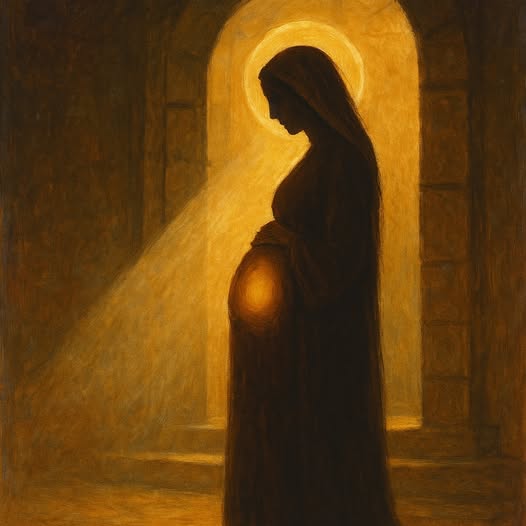
In the ancient world, sacred spaces were more than symbolic. They were believed to be real intersections between the heavens, the earth, and the underworld—cosmic structures referred to as axis mundi. These locations formed vertical bridges through which divine beings descended, humanity was judged or elevated, and spiritual rebellion was contested. Within the biblical narrative, four such mountains emerge: Eden, Hermon, Babel, and the Mount of Olives. Each represents a key stage in the battle between Yahweh and both divine and human rebellion, culminating in restoration through Jesus Christ.
Eden: The Axis Mundi Created by Sin
Eden was originally the meeting place of heaven and earth. Though Genesis 2 does not use the word “mountain,” its geography reveals elevation: a single river flows from Eden and divides into four, suggesting a high point of origin. Ezekiel 28:13–14 confirms this by describing Eden as both the Garden of God and the holy mountain of God.
At creation, Eden was a place of perfect fellowship. It connected heaven and earth, but not the underworld—death had not yet entered the picture. After Adam and Eve sinned, however, death became the fate of humanity, and Sheol—the realm of the dead—was introduced into the human condition. Eden thus became the first full axis mundi, not because it was designed to connect all three realms, but because sin brought Sheol into the equation.
The defilement of Eden marked the loss of unrestricted access between heaven and earth. Humanity was exiled, and the garden was sealed by cherubim. The axis mundi was not destroyed, but it became heavily guarded and restricted. Beings from the heavenly realm still descended at God’s command, and a few humans—like Enoch and Elijah—were taken up. Prophets continued to receive glimpses of the divine court. Yet for the rest of humanity, Eden’s sanctuary remained closed, and the descent into death through Sheol became the common path. The next major act of human rebellion would not take place until after the Flood, when Babel rose as a man-made attempt to reopen that sacred connection by force.
Mount Hermon: The Corrupted Cosmic Mountain
Mount Hermon is the second axis mundi in the biblical record. According to 1 Enoch 6, this natural mountain became the site of a supernatural rebellion. A group of divine beings known as the Watchers descended there and made a pact to corrupt humanity. Genesis 6:1–4 echoes this account, describing the “sons of God” taking human wives and producing the Nephilim—giants who filled the earth with violence and tyranny.
The name of the mountain itself comes from this rebellion: the Watchers “called the mountain Hermon because on it they had sworn and bound themselves by mutual imprecations” (1 Enoch 6:6). Hermon thus became a mountain of descent and corruption, the inverse of Eden’s holy height.
Hermon’s location adds theological weight. It overlooks Bashan, a region associated in the Old Testament with the Rephaim—departed spirits of warrior kings (Nephilim)—and with opposition to Yahweh. At the base of the mountain sat Caesarea Philippi and the Grotto of Pan—a cave widely believed in the Greco-Roman world to be a literal gate to the underworld. Pagans offered sacrifices there, casting offerings into the deep chasm in hopes of contact with the gods below.
Hermon thus became a complete counterfeit axis mundi: divine beings descending from heaven, corrupting the earth through forbidden unions, and opening a direct connection to the underworld. What Eden had been through divine blessing, Hermon became through rebellion.
Later in the Gospels, Jesus would confront this mountain directly. Many scholars believe the Transfiguration occurred on Mount Hermon. If so, then Christ stood on the site of the Watchers’ rebellion and revealed His divine glory, reclaiming the mountain for righteousness.
Babel: The Man-Made Axis Mundi
The third axis mundi is the Tower of Babel, described in Genesis 11. After the Flood, humanity united to build a structure that would reach the heavens. Their goal was not communion with God, but self-glorification and defiance of the divine mandate to spread across the earth.
This was not a generic tower. Babel was built at Eridu, the oldest known temple city in Mesopotamia. Its ziggurat was unique in that it was constructed directly above the Abzu, the cosmic deep associated with the god Enki. Unlike other ziggurats, which typically represented heaven-earth connections, Eridu’s structure symbolically bridged all three realms—heaven, earth, and the underworld.
By constructing the tower at Eridu, the builders were attempting more than ascent. They may have sought to access the imprisoned spirits of the Watchers, judged and bound in the Abyss after the Flood. Jubilees 10:7–9 describes demons attempting to contact their bound fathers. Babel was likely an effort to reopen contact with forbidden spiritual powers and reclaim forbidden knowledge through their own means.
God responded decisively. He confused their language, scattered the people, and disinherited the nations, as explained in Deuteronomy 32:8–9. The nations were assigned to lesser divine beings, and Yahweh claimed Israel as His inheritance. Babel thus marked the moment when humanity’s post-Flood rebellion triggered cosmic reordering. What Eden lost, what Hermon corrupted, Babel tried to seize by force.
The Mount of Olives: The Axis Mundi of Redemption and Return
The final axis mundi is the Mount of Olives, a mountain east of Jerusalem that bridges every phase of redemptive history. Like the others, it becomes a meeting point between heaven, earth, and the underworld—but through the life, death, resurrection, and return of Jesus Christ.
In 1 Kings 11:7–8, Solomon built altars on the Mount of Olives for Molech and Chemosh, foreign gods tied to rebellion and child sacrifice. Molech, in particular, is connected in Second Temple texts with the leader of the Hermon rebellion. Thus, the mountain was defiled as a high place for the gods of darkness, echoing the sins of Hermon.
Over time, the Mount of Olives also became the chief Jewish burial site, turning the mountain into a place of the dead. Like Eden after the Fall and Hermon in its corruption, the Mount of Olives stood as a gate to Sheol.
Jesus was arrested in the Garden of Gethsemane on the Mount of Olives. Roman law often requir execution near the place of arrest and in public view. This makes it likely that the crucifixion also took place on this mountain, visible from the road and the Temple. Jesus, the true Son of God, died on the same mountain that had once hosted altars to fallen powers.
From there, He was buried in a garden tomb nearby. He descended into the Abyss to proclaim judgment upon the imprisoned Watchers, reversing the rebellion of Hermon. Then He rose from the dead, conquering death and reclaiming the cosmic structure corrupted at every prior axis mundi.
Jesus ascended to heaven from the Mount of Olives (Acts 1:9–12), reestablishing the vertical connection lost at Eden, polluted at Hermon, and counterfeited at Babel. But His work on the mountain is not finished. Zechariah 14:4 declares that in the last days, He will return and His feet will stand on the Mount of Olives. The mountain will be split in two, forming a great valley. The place of betrayal, death, and burial will become the entry point for the kingdom of God.
Summary Comparison
Eden was created by God and linked heaven and earth until sin introduced Sheol. Its defilement came through human disobedience and resulted in a connection to the underworld.
Hermon was a natural mountain corrupted by divine rebellion. Its defilement came through descent, forbidden unions, and the opening to the underworld at its base.
Babel was a man-made structure built at Eridu. Its defilement came through human ascent in spiritual defiance, triggering divine scattering and disinheritance.
The Mount of Olives was defiled by pagan worship and became a mountain of graves. Yet through Jesus, it became the place of arrest, crucifixion, descent, resurrection, ascension, and promised return.
Conclusion
Each of the four axis mundi reveals a different phase of the cosmic struggle. Eden shows what was lost. Hermon reveals the depth of corruption. Babel illustrates the attempt to reclaim divine space by force. But the Mount of Olives points forward—to redemption, resurrection, and the return of the rightful King.
Through Jesus Christ, the true axis mundi is reestablished. The way between heaven, earth, and the underworld has been reclaimed not through pride or rebellion, but through obedience, suffering, and glory. What was closed at Eden is now open forever.
Want to Know More?
- Derek P. Gilbert, The Second Coming of Saturn: The Great Conjunction, America’s Temple, and the Return of the Watchers
This book explores the identity of the ancient rebel gods, particularly focusing on the Watchers of Mount Hermon and their prophetic return. Gilbert makes a compelling case that one of the key fallen entities may still be exerting influence and ties this directly to eschatological events. It strongly supports the view of Hermon as a corrupted axis mundi and engages deeply with Second Temple traditions and cosmic geography. - Michael S. Heiser, The Unseen Realm: Recovering the Supernatural Worldview of the Bible
A foundational work for understanding the biblical theology of sacred space, divine beings, and spiritual rebellion. Heiser unpacks passages related to Deuteronomy 32, Psalm 82, Genesis 6, and the role of Christ in restoring divine order. Essential for understanding Eden, Hermon, and Babel as theological flashpoints in cosmic geography. - Douglas Van Dorn, Giants: Sons of the Gods
This book focuses on the Nephilim, the sons of God, and their ongoing influence in the biblical narrative. Van Dorn explores Hermon, the role of the Watchers, and how Jesus deliberately confronted this dark legacy. It offers strong support for linking geography to spiritual authority and rebellion. - Tremper Longman III and John H. Walton, Lost World of the Flood: Mythology, Theology, and the Deluge Debate
This work offers valuable context for understanding the spiritual and cultural world after Eden and leading up to Babel. It includes discussion of ziggurats, ancient cosmology, and the theological significance of the Flood narrative, making it useful for situating Babel (Eridu) within the larger cosmic conflict.





